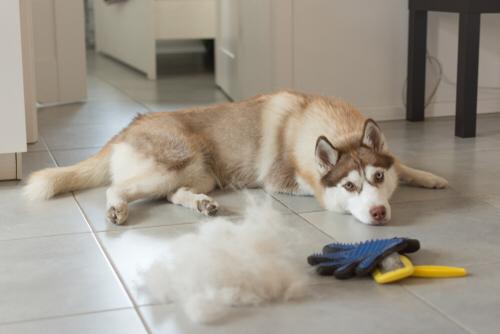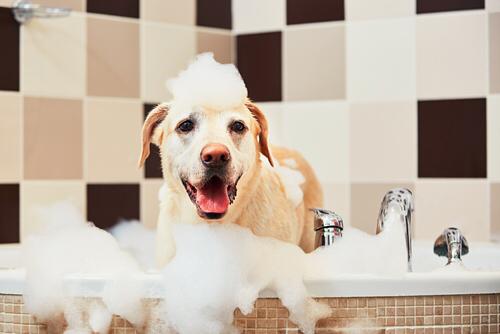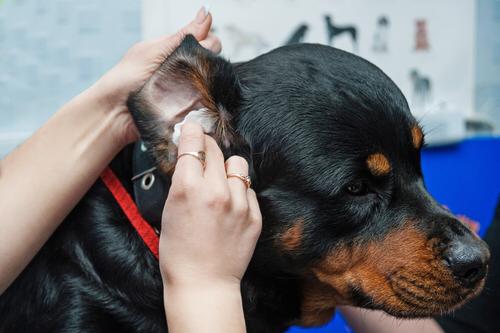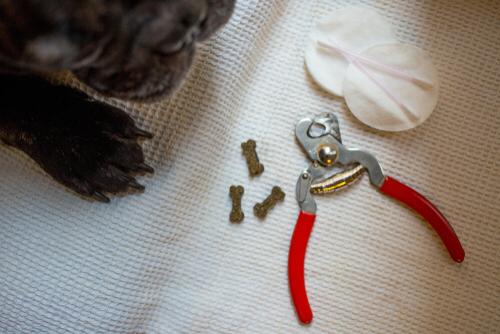If you and your best friend are missing your local groomer, here's how you can take matters into your own hands and improve your bond with your dog!
I'm pretty grateful to have a dog that doesn’t have intensive grooming needs. A bath, nail trims and lots of brushing… that’s about all Sterling needs to stay clean and groomed. And chances are, unless you’re a pet parent to a particularly furry breed of dog, your dog’s grooming needs are much like Sterling’s needs. Surprisingly, most people don’t groom their dogs at home, instead choosing to drop off their cuties at the nearest reputable dog groomer. Which makes sense considering how important grooming is to maintain good health for your dog as well as help you keep your home free of all that doggy dander. But with the current global scenario being so precarious and the pandemic looming over every social interaction we have, grooming your pet at home may be the more prudent option. Thankfully, dog grooming techniques are not terribly hard to master and there are lots of benefits to grooming your pet yourself:
- Bonding time during fur brushing
- Easy to identify skin issues early
- Nail trimming can reduce the risk of bad posture or other related problems
- Healthy, shiny coat and a cleaner home
- Saves money
Pet grooming at home can also increase the trust and bond that you share. Plus, your dog is likely A LOT more comfortable having you handle them!
So now that you know why you should consider grooming your pet at home, here’s a list of things you’ll need to cover basic grooming for your four-legged companion:
- A good brush or brushing mitt
- A pair of dog nail trimmers
- Dog shampoo
- Towel
BRUSHING:
Regular brushing is so important to a healthy, happy dog. Regular brushing can mean a shiny, healthy coat with reduced shedding and a good brushing session can help you ensure there are no visible underlying health problems that need addressing. Plus, for many dogs, brushing when introduced properly is an enjoyable activity. The second Sterling sees his brush in my hand, he gets excited and lays down — ready for the brush massage that’s coming!
There are various types of brushes you can use. For short hair dogs, a simple brush or a mitt works very well. However, if your dog has longer fur, you may make sure you have proper combs to get the knots out. Slicker brushes and rake style brushes are particularly common and do a good job of trapping loose fur and dirt.

It’s best to introduce them to brushing as early as you can. Start gently and remember to reward your dog when they behave in a positive manner during the brushing. If you have a dog that does not like being brushed, a good idea is to try a grooming mitt, which helps get rid of excess fur during a petting session. You can also distract your pup with their favourite treats while you brush them gently.
With time and positive reinforcement, not only will your bond with your dog strengthen, but you’ll also have a healthier, happier animal in your life who actively looks forward to brushing days!
BATH TIME:
Now, as much as my Sterling loves brushing, he hates bath time. Which I find rather strange because this boy likes to make a beeline for puddles after it rains or bounds full speed toward the water when we visit the beach. But being clean? Oh, no — THAT is torture!
If you’re lucky, your dog probably thinks of bath time as a lovely massage with warm water and soap. A process that’s not quite as time-consuming as you might think. But if you happen to have a dog that’s finicky like mine is during bath time, here are a few tricks that can help:

Give your dog some of their favourite treats to lure them into the space they’ll be having their bath. Building a positive association with the bath will keep them invested in an activity they don’t really like.
Make sure you talk to your dog in a calm voice and DO NOT get upset if they try to run or get away from you. Your dog is likely scared and needs reassurance. Using warm water and a rubber mitt can help them feel more comfortable as well. Keep PLENTY of treats on hand and try to associate every bath time activity with a treat to help your dog learn to enjoy baths.
Once you’re done with bath time, and your dog has shaken off all that water, be sure to towel dry your pet. You can now let them air dry, or use a hairdryer to get them dried off. The loud sound of the dryer can scare some dogs, and the overly hot air is also unpleasant. Use the cool feature on your hair dryer for much longer bursts and only dry your dog's fur about 70 percent of the way to prevent any heat damage to their fur or their sensitive skin.
Final step? Bury your nose in that lovely smelling fresh fur coat and indulge in a cuddle with your dog!
EAR CLEANING:
Every now and again, it's also a good idea to clean your dog's ear to keep pesky eat infections at bay. Doing this is super easy to boot. And if your dog is anything like mine, they will love the ear massage that comes with a quick cleaning!

All you need is some cotton or soft tissues or soft cloth. The best way to do this is to wrap a small piece of cotton or cloth around your finger and gently clean the inside of the ear. Don't dig in, just clean at the surface and just inside the ear, and your doggo should be good to go. Remember to wash your hands well after.
NAIL TRIMMING:
Now, I know it's considered bad behaviour, but lately, with Sterling and I, spending SO much of our time together, if I go out for errands or really any reason at all, when I come home it's an event: Sterling will jump and get all excited — I’m almost certain he half expects me to never come back every time the door shuts behind me. I LOVE the enthusiastic greetings. No one is ever quite as happy to see me. But the nails, if they’ve grown out, can leave a mark. More than that, if they grow out too long it can make walking on tiled floors harder, which can lead to bone-related problems.

Of all the grooming activities, dog nail clipping seems the most intimidating. Because many dogs don’t like having their paws handled. And you have to pay attention to how much of the nail you cut to avoid cutting too deep. The good news is, if you do it right (and it's very easy to do it right) your dog won’t feel a thing.
First things first, you need to make sure you have a really good sharp pair of nail trimmers. This will make your job so much easier and faster. Next, you need to make sure your dog is comfortable letting you hold their paws in your hands for a few minutes at a time. This behaviour is easily trained with the help of treats. Let your dog sniff the clippers. Hold a paw in your hand for a couple of seconds and treat when they remain calm. Increase the time gradually till you have a dog that will hold paws/hands with you for a solid few minutes.
THAT was the tough part. Now that that’s done, pay attention to your cutie’s nails. The simplest way to do this without causing anyone any pain is to start at a 45-degree angle, only trimming the tip of the nails to get rid of the curved claw and the sharp tip. If you’d like to cut your dog's nails shorter, I would recommend talking to your dog's groomer or using YouTube videos to guide you step by step. But this is the easier way of doing it, which gets the job done quite well!
I hope these tips help you conquer any fear you might have of grooming your dog during the quarantine. Sterling and I have a better bond now, thanks to grooming at home, and I can usually manage him entirely by myself without needing any help. I'm willing to bet that if you give it a shot, you’ll find that basic dog grooming is a lot less intimidating than it appears!